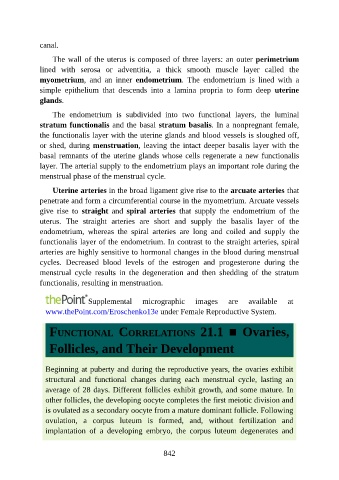Page 843 - Atlas of Histology with Functional Correlations
P. 843
canal.
The wall of the uterus is composed of three layers: an outer perimetrium
lined with serosa or adventitia, a thick smooth muscle layer called the
myometrium, and an inner endometrium. The endometrium is lined with a
simple epithelium that descends into a lamina propria to form deep uterine
glands.
The endometrium is subdivided into two functional layers, the luminal
stratum functionalis and the basal stratum basalis. In a nonpregnant female,
the functionalis layer with the uterine glands and blood vessels is sloughed off,
or shed, during menstruation, leaving the intact deeper basalis layer with the
basal remnants of the uterine glands whose cells regenerate a new functionalis
layer. The arterial supply to the endometrium plays an important role during the
menstrual phase of the menstrual cycle.
Uterine arteries in the broad ligament give rise to the arcuate arteries that
penetrate and form a circumferential course in the myometrium. Arcuate vessels
give rise to straight and spiral arteries that supply the endometrium of the
uterus. The straight arteries are short and supply the basalis layer of the
endometrium, whereas the spiral arteries are long and coiled and supply the
functionalis layer of the endometrium. In contrast to the straight arteries, spiral
arteries are highly sensitive to hormonal changes in the blood during menstrual
cycles. Decreased blood levels of the estrogen and progesterone during the
menstrual cycle results in the degeneration and then shedding of the stratum
functionalis, resulting in menstruation.
Supplemental micrographic images are available at
www.thePoint.com/Eroschenko13e under Female Reproductive System.
FUNCTIONAL CORRELATIONS 21.1 ■ Ovaries,
Follicles, and Their Development
Beginning at puberty and during the reproductive years, the ovaries exhibit
structural and functional changes during each menstrual cycle, lasting an
average of 28 days. Different follicles exhibit growth, and some mature. In
other follicles, the developing oocyte completes the first meiotic division and
is ovulated as a secondary oocyte from a mature dominant follicle. Following
ovulation, a corpus luteum is formed, and, without fertilization and
implantation of a developing embryo, the corpus luteum degenerates and
842

